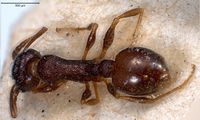Temnothorax grouvellei
| Temnothorax grouvellei | |
|---|---|

| |
| Scientific classification | |
| Kingdom: | Animalia |
| Phylum: | Arthropoda |
| Class: | Insecta |
| Order: | Hymenoptera |
| Family: | Formicidae |
| Subfamily: | Myrmicinae |
| Tribe: | Crematogastrini |
| Genus: | Temnothorax |
| Species: | T. grouvellei |
| Binomial name | |
| Temnothorax grouvellei (Bondroit, 1918) | |
Identification
Distribution
Latitudinal Distribution Pattern
Latitudinal Range: 45° to 37.816944°.
| North Temperate |
North Subtropical |
Tropical | South Subtropical |
South Temperate |
- Source: AntMaps
Distribution based on Regional Taxon Lists
Palaearctic Region: France (type locality), Iberian Peninsula, Spain.
Distribution based on AntMaps
Distribution based on AntWeb specimens
Check data from AntWeb
Countries Occupied
| Number of countries occupied by this species based on AntWiki Regional Taxon Lists. In general, fewer countries occupied indicates a narrower range, while more countries indicates a more widespread species. |

|
Estimated Abundance
| Relative abundance based on number of AntMaps records per species (this species within the purple bar). Fewer records (to the left) indicates a less abundant/encountered species while more records (to the right) indicates more abundant/encountered species. |

|
Biology
Castes
Images from AntWeb
  
| |
| Lectotype of Leptothorax grouvellei. Worker. Specimen code antweb1008440. Photographer Roland Schultz, uploaded by California Academy of Sciences. | Owned by IRSNB, Brussels, Belgium. |
Nomenclature
The following information is derived from Barry Bolton's Online Catalogue of the Ants of the World.
- grouvellei. Leptothorax grouvellei Bondroit, 1918: 135 (w.) FRANCE. Espadaler, DuMerle & Plateaux, 1983: 275 (q.m.). Combination in Temnothorax: Bolton, 2003: 271. Subspecies of niger: Emery, 1924d: 255. Revived status as species: Espadaler & Collingwood, 1982: 42.
Description
References
- Bolton, B. 2003. Synopsis and Classification of Formicidae. Mem. Am. Entomol. Inst. 71: 370pp (page 271, Combination in Temnothorax)
- Bondroit, J. 1918. Les fourmis de France et de Belgique. Ann. Soc. Entomol. Fr. 87: 1-174 (page 135, worker described)
- Borowiec, L. 2014. Catalogue of ants of Europe, the Mediterranean Basin and adjacent regions (Hymenoptera: Formicidae). Genus (Wroclaw) 25(1-2): 1-340.
- Emery, C. 1924f [1922]. Hymenoptera. Fam. Formicidae. Subfam. Myrmicinae. [concl.]. Genera Insectorum 174C: 207-397 (page 255, Variety of niger)
- Espadaler, X.; Collingwood. C. A. 1982. Notas sobre Leptothorax Mayr, 1855, con descripción de L. gredosi n. sp. (Hym. Formicidae). Bol. Asoc. Esp. Entomol. 6: 41-48 (page 42, Revived status as species)
- Espadaler, X.; Du Merle, P.; Plateaux, L. 1983. Redescription de Leptothorax grouvellei Bondroit, 1918. Notes biologiques et écologiques (Hymenoptera, Formicidae). Insectes Soc. 30: 274-286. (page 275, queen, male described)
- Gonzalez, J.A. 2021. Description of Temnothorax estel sp. nov. (Hymenoptera: Formicidae), with a review of the Iberian species of the sordidulus species-complex. Zootaxa 5005, 145–160 (doi:10.11646/zootaxa.5005.2.2).
References based on Global Ant Biodiversity Informatics
- AntArea. Accessed on February 5th 2014 at http://antarea.fr/fourmi/
- Antarea (at www.antarea.fr on June 11th 2017)
- Blatrix R., C. Lebas, C. Galkowski, P. Wegnez, P. Pimenta, and D. Morichon. 2016. Vegetation cover and elevation drive diversity and composition of ant communities (Hymenoptera: Formicidae) in a Mediterranean ecosystem. – Myrmecological News 22: 119-127.
- Borowiec L. 2014. Catalogue of ants of Europe, the Mediterranean Basin and adjacent regions (Hymenoptera: Formicidae). Genus (Wroclaw) 25(1-2): 1-340.
- Du Merle P. 1978. Les peuplements de fourmis et les peuplements d'acridiens du Mont Ventoux II. - Les peuplements de fourmis. Terre Vie 32(1): 161-218.
- Espadaler X. F. Garcia, K. Gomez, S. Serrano, and R. Vila. 2009. Ants (Hymenoptera, Formicidae) from Mont-Rebei gorge (Pallars Jussà). Boletín Sociedad Entomológica Aragonesa 44: 393399.
- Espadaler, X., P. Du Merle, and L. Plateaux. "Redescription de Leptothorax grouvellei Bondroit, 1918. Notes biologiques et ecologiques." Insectes Sociaux 30 (3) (1983): 274-286.
- Espadaler, X. "Formicidos de las sierras de Cazorla, del Pozo y Segura (Jaén, España)." Ecología 11 (1997): 489-499.
- Garcia Garcia F., X. Espadaler Gelabert, A. D. Cuesta-Segura, and D. Sanchez-Garcia. 2019. First iberian record for Temnothorax conatensis Galkowski & Lebas, 2016, and update of the distribution for Temnothorax grouvellei (Bondroit, 1918) (Hymenoptera: Formicidae). Iberomyrmex 10: 22-27.
- García F., X. Espadaler, P. Echave, and R. Vila. 2011. Hormigas (Hymenoptera, Formicidae) de los acantilados de l'Avenc de Tavertet (Osona) Boletín de la Sociedad Entomológica Aragonesa 47: 363-367.
- Lebas C., C. Galkowski, P. Wegnez, X. Espadaler, and R. Blatrix. 2015. The exceptional diversity of ants on mount Coronat (Pyrénées-Orientales), and Temnothorax gredosi(Hymenoptera, Formicidae) new to France. R.A.R.E., T. XXIV (1): 24 33

